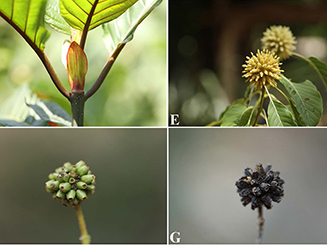Additional knowledge on the genus Mitragyna (Rubiaceae) in Thailand
DOI:
https://doi.org/10.20531/tfb.2022.50.1.03Keywords:
krathom, lectotypification, Mitragyninae, mitriform stigma, NaucleeaeAbstract
A revision of the genus Mitragyna (Rubiaceae) in Thailand is reported. Four species, i.e. M. diversifolia, M. hirsuta, M. rotundifolia, and M. speciosa are described in this taxonomic treatment. A summary of taxonomic history, detailed morphological descriptions, distributions, ecology, phenology, vernacular names, uses, IUCN conservation status, specimens examined, photographs and a key to the species are proposed. Two names are lectotypified: M. rotundifolia and M. speciosa.
Downloads
References
Bremer, B., Andreasen, K. & Olsson, D. (1995). Subfamilial and tribal relationships in the Rubiaceae based on rbcL sequence data. Annals of the Missouri Botanical Garden 82(3): 383–397. https://doi.org/10.2307/2399889
Gledhill, D. (2002). The Names of Plants. 3rd ed. Cambridge University Press, UK. 326 pages.
Govaerts, R., Ruhsam, M., Andersson, L., Robbrecht, E., Bridson, D., Davis, A., Schanzer, I. & Sonk, B. (2021). World Checklist of Rubiaceae. Facilitated by the Royal Botanic Gardens, Kew. Published on the Internet, http://wcsp.science.kew.org/. Retrieved 7 August 2021.
IUCN Standards and Petitions Committee (2019). Guidelines for Using the IUCN Red List Categories and Criteria. Version 14. Prepared by the Standards and Petitions Committee. http://www.iucnredlist.org/documents/RedListGuidelines.pdf. Accessed 19 August 2021.
IUCN (2022). The IUCN Red List of Threatened Species. Version 2021-3. http://www.iucnredlist.org/. Accessed 10 January 2022.
Löfstrand, S.D., Krüger, Å., Razafimandimbison, S.G. & Bremer, B. (2014). Phylogeny and generic delimitations in the sister tribes Hymenodictyeae and Naucleeae (Rubiaceae). Systematic Botany 39(1): 304–315. https://doi.org/10.1600/036364414X678116
Narcotic Crops Survey and Monitoring Institute, Office of the Narcotics Control Board, Ministry of Justice (2019). Academic documents on Krathom: utilization of local wisdom and research on Krathom (in Thai). Trio Advertising & Media Co. Ltd., Chiang Mai. 172 pages.
Pooma, R. & Suddee, S. (eds) (2014). Thai Plant Names, Tem Smitinand, Revised Edition 2014. Office of the Forest Herbarium,Department of National Parks, Wildlife and Plant Conservation, Bangkok. 806 pages.
Poopath, M., Karaket, P., Khammongkol, K. & Jirakorn, S. (2018). Lowland Flood Plain Forest, Northeastern (in Thai). Prachachon Co. Ltd., Bangkok. 499 pages.
POWO (2019). Plants of the World Online. Facilitated by the Royal Botanic Gardens, Kew. Published on the Internet, http://www.plantsoftheworldonline.org/. Retrieved 4 August 2021.
Puff, C., Chayamarit, K., Chamchumroon, V. & Esser, H.J. (2021). Rubiaceae (Genera 1–45). In: K. Chayamarit & H. Balslev (eds), Flora of Thailand Vol. 15 Part 1: 1–235. Prachachon Co. Ltd., Bangkok.
Radcliffe-Smith, A. (1998). Three-Language List of Botanical Name Components. Whitstable Litho Ltd., Whistable, Kent, United Kingdom. 143 pages.
Razafimandimbison, S.G. & Bremer, B. (2002). Phylogeny and classification of Naucleeae s.l. (Rubiaceae) inferred from molecular (ITS, rbcL, and trnT-F) and morphological data. American Journal of Botany 89(7): 1027–1041. https://doi.org/10.3732/ajb.89.7.1027
Ridsdale, C.E. (1978). A revision of Mitragyna and Uncaria (Rubiaceae). Blumea 24(1): 43–100. https://repository.naturalis.nl/pub/526185
Royal Institute. (2003). Plant Taxonomy the First Letter of the Thai Alphabet (in Thai). Arun Press, Bangkok. 523 pages.
Stearn, W.T. (1992). Botanical Latin: History, Grammar, Syntax, Terminology and Vocabulary. 4th edition. Redwood Books, Trowbridge for David & Charles Publishers, England. 546 pages.
WCSP (2021). World Checklist of Selected Plant Families. Facilitated by the Royal Botanic Gardens, Kew. Published on the Internet, http://wcsp.science.kew.org/. Retrieved 8 August 2021.
Wong, K.M. (1989). Rubiaceae. In: F.S.P. Ng (ed.), Tree Flora of Malaya Vol. 4, pp. 324–425. Art Printing Works Sdn. Bhd., Kuala Lumpur, Malaysia

Downloads
Published
How to Cite
Issue
Section
License
Copyright (c) 2022 Forest Herbarium

This work is licensed under a Creative Commons Attribution-NonCommercial-NoDerivatives 4.0 International License.


